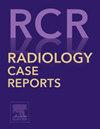Aberrant right subclavian artery (ARSA) presenting with esophageal pseudo-neoplastic symptoms, dyspepsia, and hemodynamic findings
Q4 Medicine
引用次数: 0
Abstract
Aberrant right subclavian artery (ARSA) is the most common congenital anomaly of the aortic arch. Though often asymptomatic, it may cause esophageal compression and mimic neoplastic lesions. Accurate diagnosis via CT angiography is essential, especially before thoracic or cervical surgery. A 68-year-old woman presented with dyspepsia, dyspnea, and epigastric pain. Endoscopy revealed a polypoid lesion suggestive of malignancy. CT imaging showed ARSA passing posterior to the esophagus, with no mass detected. Hemodynamic evaluation revealed inter-arm blood pressure discrepancy and bradycardia. ARSA can lead to dysphagia lusoria and other compressive symptoms. Its association with Kommerell’s diverticulum and non-recurrent laryngeal nerve has surgical implications. Treatment options include open, endovascular, and hybrid approaches. ARSA should be considered in patients with atypical esophageal symptoms. Imaging plays a key role in diagnosis and guiding appropriate, individualized treatment.
右锁骨下动脉(ARSA)异常,表现为食道假性肿瘤症状、消化不良和血流动力学表现
右锁骨下动脉异常(ARSA)是主动脉弓最常见的先天性异常。虽然通常无症状,但它可能引起食管压迫和类似肿瘤病变。通过CT血管造影进行准确诊断至关重要,尤其是在胸椎或颈椎手术之前。一名68岁女性,以消化不良、呼吸困难和上腹部疼痛为主诉。内窥镜检查显示息肉样病变提示恶性肿瘤。CT显示ARSA经食道后方,未见肿块。血流动力学评估显示臂间血压差异和心动过缓。ARSA可导致吞咽困难和其他压缩症状。它与Kommerell憩室和喉非返神经有关,具有外科意义。治疗方案包括开放、血管内和混合方法。食管症状不典型的患者应考虑ARSA。影像在诊断和指导适当的个体化治疗中起着关键作用。
本文章由计算机程序翻译,如有差异,请以英文原文为准。
求助全文
约1分钟内获得全文
求助全文
来源期刊

Radiology Case Reports
Medicine-Radiology, Nuclear Medicine and Imaging
CiteScore
1.10
自引率
0.00%
发文量
1074
审稿时长
30 days
期刊介绍:
The content of this journal is exclusively case reports that feature diagnostic imaging. Categories in which case reports can be placed include the musculoskeletal system, spine, central nervous system, head and neck, cardiovascular, chest, gastrointestinal, genitourinary, multisystem, pediatric, emergency, women''s imaging, oncologic, normal variants, medical devices, foreign bodies, interventional radiology, nuclear medicine, molecular imaging, ultrasonography, imaging artifacts, forensic, anthropological, and medical-legal. Articles must be well-documented and include a review of the appropriate literature.
 求助内容:
求助内容: 应助结果提醒方式:
应助结果提醒方式:


